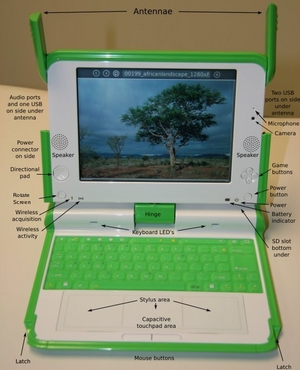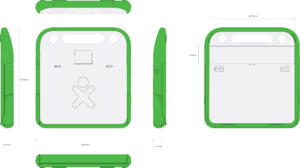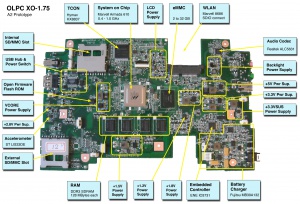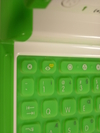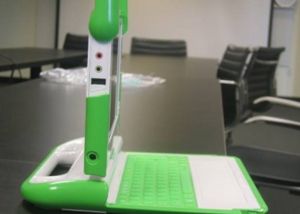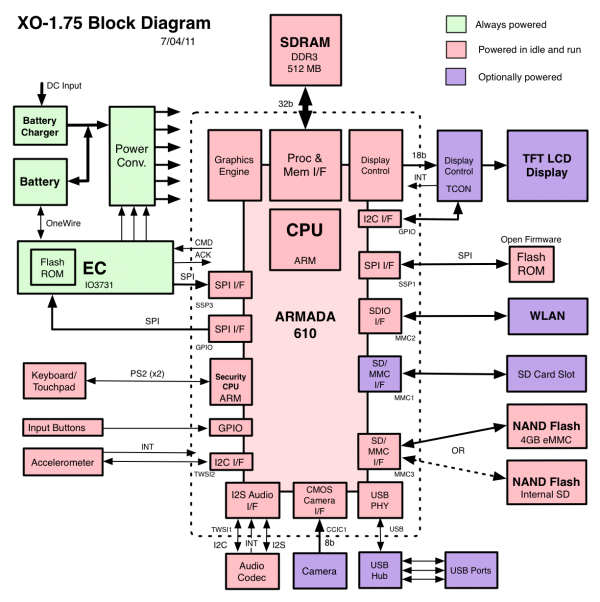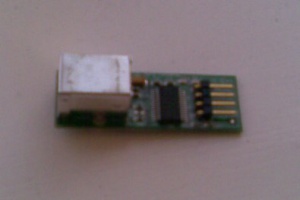XO-1.75: Difference between revisions
No edit summary |
|||
| Line 26: | Line 26: | ||
===Core electronics=== |
===Core electronics=== |
||
XO-1.75 is designed around the Marvell Armada 610 system on a chip. |
|||
| ⚫ | |||
* CPU: Marvell Sheeva ARM (PJ4); |
|||
| ⚫ | |||
| ⚫ | |||
| ⚫ | |||
| ⚫ | |||
| ⚫ | |||
| ⚫ | |||
| ⚫ | |||
| ⚫ | |||
| ⚫ | |||
* Embedded controller: ENE IO3731; |
* Embedded controller: ENE IO3731; |
||
** [[Ec_specification|Embedded Controller]]: [[Media:IO3731_v12_OLPC_20110117.pdf|IO3731]] |
** [[Ec_specification|Embedded Controller]]: [[Media:IO3731_v12_OLPC_20110117.pdf|IO3731]] |
||
* DRAM memory: 512 MB DDR3 dynamic RAM; |
* DRAM memory: 512 MB DDR3 dynamic RAM; |
||
* Mass storage: 4 GiB NAND flash in an eMMC device soldered to the motherboard. |
|||
| ⚫ | |||
| ⚫ | |||
| ⚫ | |||
** externally accessible full-size SD card slot; |
|||
| ⚫ | |||
* |
** No rotating media. |
||
* BIOS |
|||
| ⚫ | |||
| ⚫ | |||
[[Image:XO1.75_A2_mobo_annotated.jpg|thumb|Prototype Motherboard]] |
[[Image:XO1.75_A2_mobo_annotated.jpg|thumb|Prototype Motherboard]] |
||
| Line 63: | Line 70: | ||
* Touchpad: Capacitance touchpad |
* Touchpad: Capacitance touchpad |
||
* Audio: Internal stereo speakers and amplifier; internal monophonic microphone; jacks for stereo external headphones and microphones. |
* Audio: Internal stereo speakers and amplifier; internal monophonic microphone; jacks for stereo external headphones and microphones. |
||
** Realtek |
** Realtek ALC5631 audio codec (I2S) |
||
[[Image:AP1 15.jpg|thumb|100px|Keyboard detail]] |
[[Image:AP1 15.jpg|thumb|100px|Keyboard detail]] |
||
* Camera: integrated color video camera; 640 x 480 resolution at 30 FPS |
* Camera: integrated color video camera; 640 x 480 resolution at 30 FPS; |
||
** Independent (and undefeatable by software) display of microphone and camera recording status; |
|||
** The camera and device driver support disabling AGC and automatic color balancing, to enable its use as a photometric sensor for educational applications; |
|||
** [http://www.ovt.com/products/part_detail.php?id=73 Omnivision OV7670] |
** [http://www.ovt.com/products/part_detail.php?id=73 Omnivision OV7670] |
||
* [[Wireless| Wireless Networking]]: Integrated 802.11b/g (2.4GHz) interface; dual adjustable, rotating antennas support diversity reception; |
* [[Wireless| Wireless Networking]]: Integrated 802.11b/g (2.4GHz) interface; dual adjustable, rotating antennas support diversity reception; |
||
** Marvell 88w8686 WLAN module |
** Marvell 88w8686 WLAN module, with SDIO interface, on removable module; |
||
** Remains powered while the laptop suspends, waking the laptop if a packet addressed to it arrives. |
|||
** Ad-hoc networking and 802.11s mesh support available |
|||
* [[Accelerometer]]: ST LIS33 three axis accelerometer |
|||
| ⚫ | |||
* Status indicators: |
|||
| ⚫ | |||
** Microphone In-Use, and Camera In-Use, visible when lid is open. |
|||
===External connectors=== |
===External connectors=== |
||
| Line 77: | Line 93: | ||
* Headphone output: standard 3.5mm 3-pin switched stereo audio jack; |
* Headphone output: standard 3.5mm 3-pin switched stereo audio jack; |
||
* Microphone input: standard 3.5mm 3-pin switched stereo microphone jack; selectable 2V DC bias; selectable sensor-input mode (DC or AC coupled); |
* Microphone input: standard 3.5mm 3-pin switched stereo microphone jack; selectable 2V DC bias; selectable sensor-input mode (DC or AC coupled); |
||
* USB: Three Type-A USB 2.0 connectors; Up to 1A power supplied (total); |
* USB: Three Type-A USB 2.0 connectors; Up to 1A power supplied (total, available through a single connector); |
||
* Flash Expansion: full-size [[SD]] Card slot. |
* Flash Expansion: full-size [[SD]] Card slot. |
||
| Line 91: | Line 107: | ||
** Thermal and over-current sensors along with cutoff switch to protect battery; |
** Thermal and over-current sensors along with cutoff switch to protect battery; |
||
* Minimum 2,000 charge/discharge cycles (to 50% capacity of new). |
* Minimum 2,000 charge/discharge cycles (to 50% capacity of new). |
||
* [[Power Management]] will be critical |
|||
See [[Laptop Batteries]] or more information. |
See [[Laptop Batteries]] or more information. |
||
<!-- [[Image:Bottomdrawing.jpg|thumb|Battery]] --> |
|||
===BIOS/loader=== |
===BIOS/loader=== |
||
| Line 102: | Line 115: | ||
===Environmental specifications=== |
===Environmental specifications=== |
||
* Temperature: 0 to 50 degrees Celsius (operating); -20 to 60 degrees Celsius (non-operating) |
* Temperature: 0 to 50 degrees Celsius (operating); -20 to 60 degrees Celsius (non-operating) |
||
* Humidity: UL certification planned to IP42 (perhaps higher) when closed, the unit should seal well enough that children walking to and from school need not fear rainstorms and dust; |
* Humidity: UL certification planned to IP42 (perhaps higher) when closed, the unit should seal well enough that children walking to and from school need not fear rainstorms and dust; |
||
* Maximum altitude: –15m to 3048m (14.7 to 10.1 PSIA) (operating), –15m to 12192m (14.7 to 4.4 PSIA) (non-operating); |
* Maximum altitude: –15m to 3048m (14.7 to 10.1 PSIA) (operating), –15m to 12192m (14.7 to 4.4 PSIA) (non-operating); |
||
* Shock 125g, 2ms, half-sine (operating) 200g, 2ms, half-sine (non-operating); |
* Shock 125g, 2ms, half-sine (operating) 200g, 2ms, half-sine (non-operating); |
||
* Random vibration: 0.75g zero-to-peak, 10Hz to 500Hz, 0.25 oct/min sweep rate (operating); 1.5g zero-to-peak, 10Hz to 500Hz, 0.5 oct/min sweep rate (nonoperating); |
* Random vibration: 0.75g zero-to-peak, 10Hz to 500Hz, 0.25 oct/min sweep rate (operating); 1.5g zero-to-peak, 10Hz to 500Hz, 0.5 oct/min sweep rate (nonoperating); |
||
* 2-3mm plastic walls (1.3mm is typical for most systems). |
* 2-3mm plastic walls (1.3mm is typical for most systems). |
||
| Line 120: | Line 133: | ||
== Software == |
== Software == |
||
Fedora 13 |
Fedora 13 and Sugar 0.86 or later, are provided. |
||
See [http://lists.laptop.org/pipermail/devel/2010-July/029257.html the 2010 announcement]. |
See [http://lists.laptop.org/pipermail/devel/2010-July/029257.html the 2010 announcement]. |
||
As of June 2011, [http://lists.laptop.org/pipermail/devel/2011-June/032260.html early builds based on F13 beta3 for ARM are available]. |
As of June 2011, [http://lists.laptop.org/pipermail/devel/2011-June/032260.html early builds based on F13 beta3 for ARM are available]. |
||
== More Information == |
|||
See also [[Accelerometer]]. |
|||
== History == |
|||
* [[XO1.75_Bringup|XO-1.75 Bringup]] |
|||
* [[XO_1.75_A1|XO-1.75 A1]] |
|||
* [[XO_1.75_A1_ECOs|XO-1.75 A1 ECOs]] |
|||
* [[XO_1.75_HOST_to_EC_Protocol|XO-1.75 HOST to EC Protocol]] |
|||
* [[XO1.75_A1_A2_Changes|XO-1.75 A1 to A2 Changes]] |
|||
* [[XO_1.75_A2|XO-1.75 A2]] |
|||
* [[XO_1.75_A2_ECOs|XO-1.75 A2 ECOs]] |
|||
* [[XO1.75_A2_A3_Changes|XO-1.75 A2 to A3 changes]] |
|||
* [[XO_1.75_A3|XO-1.75 A3]] |
|||
* [[XO_1.75_B1|XO-1.75 B1]] |
* [[XO_1.75_B1|XO-1.75 B1]] |
||
* [[Firmware#XO-1.75|Firmware]] |
* [[Firmware#XO-1.75|Firmware]] |
||
* [[Forth_Lesson_20#ARM_Startup| |
* [[Forth_Lesson_20#ARM_Startup|Open Firmware ARM Startup]] |
||
* [http://build.laptop.org/ |
* [http://build.laptop.org/F13-arm/ Software builds] |
||
==Serial Adapter== |
==Serial Adapter== |
||
Revision as of 03:35, 21 July 2011
| Please copy/paste "{{Translationlist | xx | origlang=en | translated={{{translated}}}}}" (where xx is ISO 639 language code for your translation) to XO-1.75/translations | HowTo [ID# 258371] +/- |
Work is ongoing on this page.
The XO-1.75 Laptop
The XO-1.75 laptopis a refresh of the XO-1 and XO-1.5 laptops. In our continued effort to maintain a low price point, OLPC is again refreshing the hardware to take advantage of the latest component technologies. This design, while separate from the XO-3 tablet effort, uses the same very low power electrical design. It continues to use the same industrial design and batteries as XO-1. The design goal is to provide an overall update of the system within the same industrial design and external appearance. Overall, the target was to greatly improve the power consumption while reducing the purchase cost.
Gen 1.75 machines will ship with a new software release based on Fedora 13 and including both Sugar and GNOME software.
Specifications
The definitive XO-1.75 laptop specification will be available soon. CL1B hardware specification ("CL2" is the model identifier in the manufacturing data for the XO-1.75 hardware).
- The specs below are not authoritative, please refer to the PDF version of the spec linked above.
Physical dimensions
- Approximate dimensions: 245mm × 230mm × 30.5mm (see drawing to the right for detailed dimensions)
- Approximate weight:
- XO laptop with LiFePO4 battery: 1.45KG (~3.20lbs);
- Configuration: Convertible laptop with pivoting, reversible display; dirt- and moisture-resistant system enclosure; no fan.
Core electronics
XO-1.75 is designed around the Marvell Armada 610 system on a chip.
- CPU: Marvell Sheeva ARM (PJ4);
- CPU clock speed: 800 MHz;
- ARM instruction set compatible (including Thumb-2 and Wireless MMX2);
- ARMv7 architecture compatible;
- 32 KB L1 I-cache, 32 KB L1 D-cache, 256KB L2 cache;
- The SoC includes hardware video encode/decode, a 3D graphics engine, display controller, USB, SDIO, and other system interface and management functions
- Embedded controller: ENE IO3731;
- DRAM memory: 512 MB DDR3 dynamic RAM;
- Mass storage: 4 GiB NAND flash in an eMMC device soldered to the motherboard.
- An internal full size SD card is provided for repair/replacement (not user-changeable without opening the unit with a screwdriver);
- externally accessible full-size SD card slot;
- No rotating media.
- BIOS
- Open Firmware used for diagnostics and loading OS;
- dedicated 1 MiB SPI-interface flash ROM;
Display
- Main article: Display
- Liquid-crystal display: 7.5” dual-mode TFT display;
- Viewing area: 152.4 mm × 114.3 mm;
- Two "modes" depending on lighting conditions:
- (1) Grayscale (B&W) reflective mode: for outdoor use—sunlight-readable; primarily lit from the front by ambient light; high-resolution (200 DPI), 1200(H) × 900(V) grayscale pixels; power consumption 0.1–0.2Watts;
- (2) Color, backlight mode: for indoor use; primarily lit from behind by the LED backlight; built in sub-pixel sampling of the displayed color information results in a perceived resolution of approximately 984(H) × 738(V); power consumption 0.2–1.0Watts;
- The display-controller chip (DCON) formats data for the display.
- Note: web browser images are currently scaled up so that an image of very roughly [800 × 600] fills up the browser window.
Integrated peripherals
- Keyboard: 80+ keys, 1.0mm stroke; sealed rubber-membrane key-switch assembly;
- Keyboard Layouts
- Layout pictures: English, Arabic, Thai, West African (Nigeria), Portuguese, Spanish, Amharic, French, Urdu, Cyrillic, Turkish (not final), Nepali, Mongolian, Kazakh, Devanagari, Uzbek, Pashto, Dari, Pulaar (Fula), Italian
- A non-membrane "traditional" keyboard is also available.
- Gamepad: Two sets of four-direction cursor-control keys;
- Touchpad: Capacitance touchpad
- Audio: Internal stereo speakers and amplifier; internal monophonic microphone; jacks for stereo external headphones and microphones.
- Realtek ALC5631 audio codec (I2S)
- Camera: integrated color video camera; 640 x 480 resolution at 30 FPS;
- Independent (and undefeatable by software) display of microphone and camera recording status;
- The camera and device driver support disabling AGC and automatic color balancing, to enable its use as a photometric sensor for educational applications;
- Omnivision OV7670
- Wireless Networking: Integrated 802.11b/g (2.4GHz) interface; dual adjustable, rotating antennas support diversity reception;
- Marvell 88w8686 WLAN module, with SDIO interface, on removable module;
- Remains powered while the laptop suspends, waking the laptop if a packet addressed to it arrives.
- Ad-hoc networking and 802.11s mesh support available
- Accelerometer: ST LIS33 three axis accelerometer
- Status indicators:
- Power, battery, Wi-Fi, one software controlled (intended for onboard flash access), visible with lid open or closed;
- Microphone In-Use, and Camera In-Use, visible when lid is open.
External connectors
- DC power: 6mm (1.65mm center pin) connector; 11 to 24 V input usable, –32 to +40V input tolerated; power draw limited to 25 W; - see power connector dimensions at Battery and power.
- Maximum Power Point Tracking alters voltage/current for maximum battery-charging power from solar panels
- Headphone output: standard 3.5mm 3-pin switched stereo audio jack;
- Microphone input: standard 3.5mm 3-pin switched stereo microphone jack; selectable 2V DC bias; selectable sensor-input mode (DC or AC coupled);
- USB: Three Type-A USB 2.0 connectors; Up to 1A power supplied (total, available through a single connector);
- Flash Expansion: full-size SD Card slot.
Battery
- Pack type: 2 cell LiFePO4, approx. 6V series configuration;
- Capacity: 22 Watt-hours (LiFeP);
- Fully-enclosed “hard” case; user removable;
- Electronics integrated with the pack provide:
- Identification;
- Battery charge and capacity monitoring chip (Maxim DS2756 data sheet);
- Thermal and over-current sensors along with cutoff switch to protect battery;
- Minimum 2,000 charge/discharge cycles (to 50% capacity of new).
See Laptop Batteries or more information.
BIOS/loader
- Open Firmware (including hardware initialization and diagnostics).
Environmental specifications
- Temperature: 0 to 50 degrees Celsius (operating); -20 to 60 degrees Celsius (non-operating)
- Humidity: UL certification planned to IP42 (perhaps higher) when closed, the unit should seal well enough that children walking to and from school need not fear rainstorms and dust;
- Maximum altitude: –15m to 3048m (14.7 to 10.1 PSIA) (operating), –15m to 12192m (14.7 to 4.4 PSIA) (non-operating);
- Shock 125g, 2ms, half-sine (operating) 200g, 2ms, half-sine (non-operating);
- Random vibration: 0.75g zero-to-peak, 10Hz to 500Hz, 0.25 oct/min sweep rate (operating); 1.5g zero-to-peak, 10Hz to 500Hz, 0.5 oct/min sweep rate (nonoperating);
- 2-3mm plastic walls (1.3mm is typical for most systems).
Regulatory requirements
- The usual US and EU EMI/EMC (electromagnetic-interference and electromagnetic-compatibility) requirements;
- The laptop meets IEC 60950-1, EN 60950-1, and CSA/UL 60950-1 (safety) specifications. It also complies with UL 1310 and UL 498. In order to guarantee the safety of children using the laptop, it passes ASTM F 963 (Standard Consumer Safety Specification on Toy Safety, 2003 edition);
- The external power adapter complies with IEC, EN, and CSA/UL 60950-1;
- The removable battery pack complies with IEC, EN, and CSA/UL 60950-1 and UL 2054;
- RoHS (Restriction of Hazardous Substances Directive – EU) compliant.
Block Diagram
Software
Fedora 13 and Sugar 0.86 or later, are provided.
See the 2010 announcement. As of June 2011, early builds based on F13 beta3 for ARM are available.
More Information
Serial Adapter
For firmware, operating system and kernel debugging a serial adapter is required. We are using our third generation serial adapter with the XO-1.75, which has 3.3V serial on the target side, and a USB B socket on the host side.
